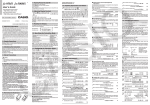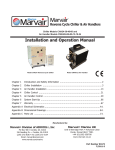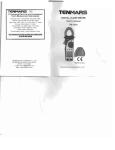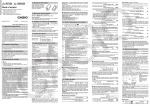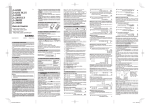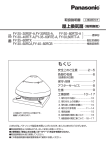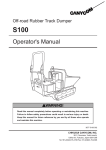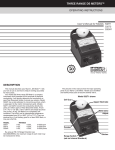Download Simplicity 760 Specifications
Transcript
AQUASWITCH AQUASWITCH & 760-A AQUASWITCH Operation Manual INSTALLATION • OPERATION • MAINTENANCE 22 August 05 ACCURACY • RELIABILITY • SIMPLICITY Water Quality Instrumentation Accuracy • Reliability • Simplicity TABLE OF CONTENTS SECTION PAGE 1 INTRODUCTION 1.1 SCOPE ................................................................................................................................. 1 1.1.1 Functional Descriptions ............................................................................................ 1 1.1.2 Applications .................................................................................................. 1 1.2 SPECIFICATIONS ................................................................................................................ 1 1.2.1 Aquaswitch ............................................................................................................... 1 1.2.2 760-A Aquaswitch ..................................................................................................... 1 1.2.3 HP Solenoid Pilot Valves .......................................................................................... 2 1.2.4 Resistivity Cell .......................................................................................................... 2 1.3 HOW TO ORDER ................................................................................................................. 2 2 INSTALLATION 2.1 GENERAL ............................................................................................................................. 3 2.2 MECHANICAL INSTALLATION............................................................................................. 3 2.2.1 Surface Mounting ..................................................................................................... 4 2.2.2 Panel Mounting Installation ...................................................................................... 4 2.2.3 HP Solenoid Pilot Valve Installation ......................................................................... 4 2.2.4 Cell Installation ........................................................................................................ 4 2.3 ELECTRICAL INSTALLATION ............................................................................................. 5 2.3.1 Aquaswitch Main AC Power ..................................................................................... 5 2.3.2 760-A Aquaswitch Main AC Power .......................................................................... 5 2.3.3 220 VAC Conversion ............................................................................................... 6 2.3.4 Pilot Valve Solenoid Connections (Also see pg. 13) ................................................ 6 2.3.4.1 Optional Solenoid Power .......................................................................... 6 2.3.5 Cell Connections ...................................................................................................... 6 2.3.6 Alarm Relay ............................................................................................................. 7 3 OPERATING PROCEDURES 3.1 GENERAL ............................................................................................................................ 8 3.2 SWITCH AND INDICATOR CONTROLS .............................................................................. 8 3.3 OPERATIONAL CHECK-OUT PROCEDURES ................................................................... 9 3.3.1 760-A Aquaswitch .................................................................................................... 9 3.3.2 Aquaswitch .............................................................................................................. 9 4 COMPONENT IDENTIFICATION, CALIBRATION AND PREVENTIVE CARE 4.1 GENERAL ........................................................................................................................... 10 4.2 PRIMARY COMPONENT IDENTIFICATION ..................................................................... 10 4.3 “PURGE CYCLE” CALIBRATION PROCEDURES ............................................................ 11 4.4 “ALARM RESET” JUMPER ADJUSTMENT ....................................................................... 12 4.5 760-A AQUASWITCH CALIBRATION PROCEDURES ..................................................... 12 4.5.1 Meter Mechanical Zero Reading ............................................................................ 12 4.5.2 Internal Set Point Adjustment ................................................................................. 12 4.5.3 Full Scale Calibration Procedures .......................................................................... 13 4.6 PREVENTIVE CARE ......................................................................................................... 13 5 APPENDIX A REPLACEABLE COMPONENTS CHART .......................................................................... 14 B WARRANTY........................................................................................................................ 14 SECTION 1 Introduction 1.1 SCOPE This manual provides the necessary information to install, operate and maintain the Myron L Company’s Aquaswitch/760A Aquaswitch. Sections 1 through 3 provide the user with an applicational description, mounting, wiring and operational procedures. Section 4 identifies their primary components and provides the user with easy-to-use calibration and preventive care procedures. Section 5 (Appendix A) provides an easily understood Replaceable Components Chart. 1.1.1 FUNCTIONAL DESCRIPTIONS 5 Power Plants 6 Laboratories 1.2 SPECIFICATIONS 1.2.1 AQUASWITCH INPUT POWER: 115 VAC ±15% 220 VAC ±15% (user changeable to 220 VAC) OUTPUT POWER: 24 VAC (Standard if ordered with Myron L valves) 115 VAC (Standard if ordered without Myron L valves) 220 VAC (Optional) Both instruments have drip/weather-proof housings which can be panel or surface mounted. The Aquaswitch is packaged within a compact 6.0" x 4.8" (152mm x 122mm) housing. The 760-A Aquaswitch is packaged within a 6.0" x 10.8" (152mm x 274mm) housing. The standard Aquaswitch does not monitor water quality itself, but should be used with any reliable resistivity controller such as the Myron L Company’s 750/760 Series Resistivity Controllers. MAXIMUM LOAD PER VALVE OUTPUT: 200 milliamps; ( 5 watts for a 24 V valve) (25 watts for a 115 V valve) (50 watts for a 220 V valve) NOTE: The 760-A Aquaswitch is an integrated unit requiring no other Controller. HOUSING CONSTRUCTION: Fully gasketed heavy-duty ABS for corrosion resistance. Rated NEMA type 3. AQUASWITCH DIMENSIONS: Aquaswitch: 6" (152mm) H x 4.8" (122mm) W x 3.8" (97mm) D 760-A Aquaswitch: 6" (152mm) H x 10.8" (274mm) W x 3.9" (99mm) D Provides automatic switching from exhausted to fresh Dl banks; push-button override for immediate bank change-over; adjustable purge timer for “FAILSAFE” operation; front panel LED displays provide continual status of both Dl banks; and an alarm is automatically activated as each bank is depleted. 760-A AQUASWITCH The 760-A Aquaswitch combines the operating features of the standard Aquaswitch with the additional features of a resistivity Controller. These include: a linear display meter and a front panel accessible “SET POINT CHECK” switch. (Set point setting is internal to discourage unauthorized adjustments). NOTE: All specifications for the 760-A Aquaswitch also apply to resistivity Controller models 760-A2, and 760-A3 unless otherwise indicated. 1.1.2 APPLICATIONS 1 2 3 4 Deionization (Dl) ultra-pure water treatment systems Electronics Food Processing Plating AMBIENT TEMPERATURE RANGE: -22°F (-30°C) to 140°F (60°C) SHIPPING WEIGHT: Aquaswitch: 3 Ibs. (1.36 kg.) 760-A Aquaswitch: 5 Ibs. (2.27 kg.) ALARM RELAY CONTACT RATING: SPDT 10 amp @ 250 VAC (Non-Inductive), 30 VDC 1.2.2 760-A AQUASWITCH RANGE: 0-20 megohm-cm 0-2 megohm-cm (Model 760-A2) 0-200 kilohm-cm (Model 760-A3) READOUT: 4 1/2" (114mm) Analog ACCURACY: ±2% of span CELL INPUT: 1 CS10 Series cell required RELAY FUNCTION: Single set point control Continuously adjustable 0-100% of span SPDT 10 amp @ 250 VAC (Non-lnductive), 30 VDC 1 1.2.3 HP SOLENOID PILOT VALVES CS10 CELL SPECIFICATIONS DESCRIPTION: Being corrosive, ultra-pure water can be difficult to control. Myron L HP valves solve this problem by utilizing tap water or air to open and close the diaphragm. HP valves, therefore, are ideal for use with the Aquaswitch and many other water corrosive solution applications. CONSTANT: 0.05 SPECIFICATIONS PRESSURE/TEMPERATURE LIMITS: 100 psi (690 kPa) / 212°F (100°C) SIZES: 1", 2", or 3" IPS; compatible with plastic or metal piping. POWER: 24 VAC (2 watts) MATERIALS: Body: Diaphragm: O Ring: Exterior Metal: Dupont ZYTEL (33% glass reinforced NYLON) NYLON reinforced BUNA N synthetic rubber DELRIN 18-8 stainless steel (1"); brass (2" and 3") OPERATING PRESSURE: N.O.: 3-90 psi (21-620 kPa) N.C.: 3-150 psi (21-1034 kPa) PRESSURE LOSS: (See chart below) WATER TEMPERATURE: 40°F (4°C) to 185°F (85°C) SOLENOID PILOT PRESSURE: Water: Min. - equal to Dl water line pressure Max. N.O. - 90 psi/max. N.C. - 150 psi Air: Min. - 2X Dl water line pressure Max N.O. - 90m psi Max. N.C. - 150 psi 1.2.4 RESISTIVITY CELL DESCRIPTION: The 760-A Aquaswitch uses a CS10 Cell. These reliable sensors feature two integral thermistors to ensure accurate and rapid automatic temperature compensation. The sturdy polypropylene bushing is modular for easy, inexpensive replacement. Several alternatives for the metal portion of the cell are available, depending on the demands of the application. 2 TEMPERATURE COMPENSATION: Two integral thermistors provide automatic TC to 25°C over the range of 0-100°C (32-212°F) BUSHING: Modular Polypropylene threaded .75" NPT CABLE: Shielded; 10'(3 meters) standard; Prespecified lengths up to 100' (30 meters) also available. DIMENSIONS: Metal portion 3.75" (95mm)L; 0.5" (13mm) DIA 1.3 HOW TO ORDER 1. 2. 3. 4. Choose either the Aquaswitch or 760-A Aquaswitch If 760-A Aquaswitch, also select a resistivity cell: CS10-S (316 stainless steel) CS10-T (titanium) CS10-M (Monel*) Valves (three or four are required): 024-1HP (1 “ 24v) 024-2HP (2" 24v) 024-3HP (3" 24v) 24V power is required for use with 24V valves such as 024HP series. A 115V to 24V step-down transformer accessory is available. Order Model VR. Example of a complete system: 760-A Aquaswitch with CS10-S cell, VR transformer and 4 Model 024-1HP valves. *TM Huntington Alloy, Inc. SECTION 2 Installation 2.1 GENERAL 2.2 MECHANICAL INSTALLATION Section 2.2 provides the user with the recommended procedures for mounting the Aquaswitch/760-A Aquaswitch and for completing their necessary electrical installation. All Aquaswitch and 760-A Aquaswitch electronics are packaged inside drip/weather-proof housings. Their physical dimensions have been designed to allow for both surface and panel mounting. NOTE: The Myron L Company recommends that all mounting and electrical installation procedures be performed by trained and authorized personnel ONLY! Failure to do so could result in damage to equipment and/or property There are three basic guidelines to consider when selecting the Aquaswitch’s mounting location: 1 Select a site that limits the Aquaswitch’s exposure to excessive moisture and corrosive fumes. 2 For best results, position your control area as close as possible to the point(s) being controlled 3 NOTE: The 760-A Aquaswitch is not designed to operate with a Cell cable length that exceeds 100' (30 meters). 3 If at all possible, mount the Controller at eye level for viewing convenience. 2.2.1 SURFACE MOUNTING NOTE: Surface mounting will require two (2) user supplied 1/4” 20 mounting screws See, Fig. 2-1 for hole drilling locations. For ease of surface mounting, a surface mounting plate is available. Order Part No.: SMP50 for Aquaswitch SMP60 for 760-A Aquaswitch STEP 1 Select your site location. Mark and drill the two (2) required mounting holes. STEP 2 lace the mounting threads in alignment with the surface mounting holes. STEP 3 Insert and securely fasten the two (2)1/4':20 mounting screws. 2.2.2 PANEL MOUNTING INSTALLATION A panel mounting fastening kit is provided with all Aquaswitch/ 760-A Aquaswitch enclosures. Panel mounting will require the use of the fastening kit’s two (2) 4-40 mounting screws/nuts or two (2) #4 x 1/2 “ sheet metal screws. See Fig. 2-1 for panel cutout dimensions. STEP 1 Select your site location, mark the appropriate pane I cut out and complete the necessary panel cut. STEP 2 Carefully unfasten and separate the front panel from its enclosure. STEP 3 Disconnect all panel cable(s)/wires from the enclosure’s component board(s). STEP 4 Slide the enclosure through the panel cutout until its flange contacts the panel. STEP 5 Insert mounting screws through the flange mounting holes and tightly secure. STEP 6 Reconnect all panel cable(s)/wires. (See Fig. 4-1) 2.2.3 HP SOLENOID PILOT VALVE INSTALLATION STEP 1 Insert the pilot valve unit so that the systems’ INFLOW source and OUTFLOW process piping connecting ends are inserted into the valve as shown in Fig. 2-2. STEP 2 Repeat STEP 1 until all appropriate pilot valve units have been installed. NOTE: The number of pilot valves used will be based upon the user’s desired application. 4 2.2.4 CELL INSTALLATION (MODEL 760-A ONLY) NOTE: Fig. 2-3 illustrates how to properly assemble and install the CS10 Cell assembly into a “T” type mounting fixture. Improper assembly could result in damage to equipment and/or property. A CS10 Cell’s mounting orientation must provide a continuous and adequate circulation flow to prevent the trapping of air bubbles within the Cell’s electrode area. Failure to do so will result in conditions that will prevent the cell from functioning properly. STEP 1 Verify that the Cell components are properly assembled. STEP 2 Insert the Cell assembly into the “T” mounting fixture as shown in Fig. 2-3 and tightly secure. 2.3 ELECTRICAL INSTALLATION The Aquaswitch and 760-A Aquaswitch require the user to follow separate electrical installation procedures. In addition, based on the user’s solenoid voltage specifications, the user will be required to connect optional Solenoid Power. NOTE: All cable watertight restraints are user supplied 2.3.1 AQUASWITCH MAIN AC POWER NOTE: The following procedures are to be used to install the Aquaswitch 115 VAC main power source. For the procedures to install the optional 220 VAC main power source, the user must first complete the installation procedures in Section 2.3.3. Failure to do so could result in damage to equipment, and/or property. STEP 1 Verify that the facility’s 115 VAC power source is turned OFF or disconnected. STEP 2 Following STEPS 2 and 3 in Section 2.2.2, remove the front panel. STEP 3 Place the AC power cord and watertight cable restraint into the enclosure’s appropriate access hole. STEP 4 Neatly connect cable wires to the 760-A Control board TB1 terminal block connectors as shown in Fig. 2-5. 5 2.3.2 760-A AQUASWITCH MAIN AC POWER NOTE: The following procedures are to be used to install the 760-A Aquaswitch 115 VAC main power source. For the procedures to install the optional 220 VAC main power source, the user must first complete the installation procedures in Section 2.3.3. Failure to do so could result in damage to equipment and/or property. STEP 1 Verify that the facility’s 115 VAC power source is turned OFF or disconnected. STEP 2 Following STEPS 2 and 3 in Section 2.2.2, remove the front panel. STEP 3 Place the facility’s AC power cord and watertight cable restraint into the enclosure’s appropriate access hole. STEP 4 Neatly connect cable wires to the 760-A Control board TB1 terminal block connectors as shown in Fig. 2-6. 760-A AQUASWITCH 2.3.3 220 VAC CONVERSION STEP 1 Verify that the facility’s 115 VAC power source is turned OFF or disconnected. AQUASWITCH STEP 2 Locate and remove 760-A Control board jumpers E1 and E3. (See Fig. 4-1) STEP 1 Verify that the facility’s 115 VAC power source is turned OFF or disconnected. STEP 3 Using one of the removed jumpers, insert it into jumper E2’s connection holes as shown in Fig. 2-8. STEP 2 Locate and remove Power Module jumpers E1 and E2. (See Fig. 4-1) STEP 4 Follow STEPS 2 and 3 in Section 2.3.3 to convert the Power Module 115/220 VAC jumpers. STEP 3 Using one of the removed jumpers, insert it into jumper E3’s connection holes as shown in Fig. 2-7. 6 2.3.4 PILOT VALVE SOLENOID CONNECTIONS 2.3.5 CELL CONNECTIONS (MODEL 760-A ONLY) NOTE: Section 2.3.4 provides the procedures for installing 115 VAC solenoid valves with maximum load rates of 25 watts per valve. For the procedures to install solenoid valves other than 115 VAC, see Section 2.3.4.1. (Refer to Fig. 2-10 for recommended valve wiring.) STEP 1 Place the CS10 Cell’s interface cable and watertight cable restraint into the enclosure’s appropriate access hole. STEP 1 Place the Bank A solenoid interface cable and watertight cable restraint into the enclosure’s appropriate access hole. 2.3.6 ALARM RELAY INSTALLATION STEP 2 Neatly connect the cable wires to Power Module terminal block TB2 as shown in Fig. 2-5. STEP 3 Repeat Steps 1 and 2 to install the Bank B solenoid interface cable. STEP 4 Repeat Steps 1 and 2 to install the Bleed Valve solenoid interface cable. STEP 2 Neatly connect the cable wires to the 760-A Control board terminal block TB3 as shown in Fig. 2-6 STEP 1 Place the user supplied Alarm relay interface cable and watertight cable restraint into the enclosure’s appropriate access hole. STEP 2 Neatly connect cable wires to the Power Module TB3 terminal connectors as shown in Fig. 2-5. NOTE: See Section 4.4 for the “ALARM RESET” jumper adjustments. STEP 5 (Optional) Repeat Steps 1 and 2 to install the Process valve solenoid interface cable. 2.3.4.1 OPTIONAL SOLENOID POWER CAUTION! Prior to connecting any solenoid valves other than 115 VAC, it is essential that the user remove Power Module jumpers E4 and E5 as shown in Fig. 2-5 (detail in Fig. 2.9 below). Failure to do so could result in damage to the equipment and/or property. STEP 1 Place the optional solenoid power cable and watertight cable restraint into the enclosure’s appropriate access hole. STEP 2 Connect the cable wires to the Power Module terminal block TB2 as shown in Fig. 2-5. 7 SECTION 3 Operating Procedures 3.1 GENERAL 3.2 SWITCH AND INDICATOR CONTROLS Section 3.2 provides the operational descriptions for each of the Aquaswitch/760-A Aquaswitch switch and indicator controls. Section 3.3 provides the user with recommended checkout procedures. AQUASWITCH BANK A/B “IN USE” Indicators The amber “IN USE” LED indicator light is ON only when its respective Bank’s solenoid valve is energized. NOTE: The units have been designed so that only one (1) Bank (either A or B) can be in use at any time. Water Quality “GOOD” Status Indicators The green “GOOD” status LED light indicators are ON when their respective Bank’s water quality is acceptable (ABOVE Controller Set Point). Water Quality “POOR” Status Indicators The red “POOR” status LED light indicators are ON only when their respective Bank’s water quality is unacceptable (BELOW Controller Set Point). “BLEED” Indicator Light The amber “BLEED” LED indicator light is ON only when the Aquaswitch is in its Purge Cycle (Bleed/Process Water valve(s) are activated). “BANK SWITCH” Push Button When the “BANK SWITCH” is depressed, the Aquaswitch automatically switches Banks, i.e. turns OFF the currently selected Bank and turns ON the alternate Bank. “ALARM RESET” Push Button. When the-”ALARM RESET” switch is depressed, the Aquaswitch will automatically turn OFF the Alarm. 760-A AQUASWITCH 4 1/2" ANALOG METER The 4 1/2" (114mm) linear analog meter provides a continuous readout of the water being monitored. “ABOVE/BELOW” Set Point Indicators The green LED indicator light is ON only when the resistance of the water is ABOVE the Controller’s internal Set Point. The red LED indicator light is ON only when the resistance of the water is BELOW the Controller’s internal Set Point. “SET POINT CHECK” Switch When the “SET POINT CHECK” switch is depressed, the internal Set Point reading is immediately displayed on the analog meter. 8 3.3 OPERATIONAL CHECKOUT PROCEDURES 3.1 The following checkout procedures are used to verify that the Aquaswitch or 760-A Aquaswitch is operating properly. 3.2 NOTE: To complete the checkout procedure, it is assumed that the system is fully installed and the Aquaswitch is connected to a reliable resistivity Controller or a 760-A Aquaswitch is installed. It is also assumed that two fresh Dl banks are on line with the system and the Controller is indicating water quality in the desired range. During this test procedure, it will be necessary to simulate GOOD and POOR water quality. This is done by setting the Set Point to BELOW or ABOVE the Controller’s actual water resistance reading. When the Set Point is set BELOW (counterclockwise), the monitor will simulate “GOOD” water quality. “POOR” water quality is simulated by setting the Set Point ABOVE (clockwise) the actual water quality. 3.3.1 760-A AQUASWITCH (ONLY) STEP 1 Using the “SET POINT CHECK” switch, verify that the meter indicates the desired Set Point. NOTE: If the meter does not indicate the correct Set Point setting, reference Section 4.5.2 for the procedures to readjust the 760-A Aquaswitch’s internal Set Point. STEP 2 Observe resistance reading of water being monitored. STEP 3 With front panel removed, depress “SET POINT CHECK” switch and observe the reading on the analog meter. With a small screwdriver, adjust the Set Point trimmer (R31) (See Fig. 4-1) to above the reading observed in STEP 2. Release the “SET POINT CHECK” switch and observe that the red “POOR” light is ON. STEP 4 Depress the “SET POINT CHECK” switch and adjust screw adjustment (R31) until the Set Point is below the reading observed in STEP 2. Release the “SET POINT CHECK” switch and observe that the green “ABOVE” light is ON. Also note the audible click of the relay as the lights change. STEP 5 Readjust the Set Point trimmer (R31) to the desired Set Point setting and replace front panel. This completes the 760-A Aquaswitch Control board checkout. 3.3.2 AQUASWITCH / 760-A AQUASWITCH NOTE: For 760-A Aquaswitch users, the term “Controller” refers to the 760-A Control Board functions. STEP 1 Turn the Purge Cycle trimmer adjustment screw (R2) fully clockwise to obtain an approximate one minute cycle. (See Fig. 4-1) STEP 2 Adjust Controller “Set Point” to simulate “GOOD” water quality (for the 760-A Aquaswitch, turn the Set Point trimmer adjustment screw (R31) counterclockwise (see Section 4.5.2)) and verify the following sequence of operation. STEP 3 Push “BANK SWITCH” several times to verify the following Controller operations. 3.3 3.4 Verify that the “IN USE” indicator lights switch ON and OFF between Banks A and B each time “BANK SWITCH” is pressed. Verify that both Banks A/B “GOOD” water quality lights remain ON. Verify that the “BLEED” light remains OFF. Leave BANK A ON for next step. (If required, push the “ALARM RESET” switch to reset alarm.) NOTE: If the Logic Module Alarm Reset jumper has been installed to provide the user with the optional Manual Bank Switch alarm condition, the alarm will be activated each time the “BANK SWITCH” is pressed. Otherwise, the alarm will be activated only when the Purge Cycle time setting has expired. (Refer to Section 4.4) STEP 4 Adjust Controller Set Point to simulate “POOR” water quality. (For the 760-A Aquaswitch, turn Set Point trimmer adjustment screw (R31) clockwise, and verify the following sequence of operation.) 4.1 4.2 4.3 4.4 BANK A water quality indicates “POOR.” Yellow “BLEED” light turns ON and water is purged from system. (This should continue for about 1 minute.) After 1 minute, BANK A will turn OFF and BANK B will turn ON and indicate “POOR” water quality. After approximately 1 minute, BANK B should turn OFF, the “BLEED” light should turn OFF, the Bleed valve should close and the alarm should be activated. The system is now entirely shut down. NOTE: If an external alarm is connected, it will be activated when the Aquaswitch switches Banks. (Press the “ALARM RESET” switch to turn OFF alarm.) If an alarm is not connected, an alarm condition can be monitored by connecting an ohm meter across Power Module Terminals TB32 and TB3-3. The meter should indicate a CLOSED CIRCUIT in the alarm condition. STEP 5 Adjust the Controller Set Point to simulate “GOOD” water quality. (For the 760-A Aquaswitch, turn Set Point trimmer adjustment screw (R31) counterclockwise and verify the following sequence of operation.) STEP 6 Press the “BANK SWITCH.” The BANK A “IN USE” and “GOOD” water quality indicator lights should turn ON. Press the “BANK SWITCH” again and BANK B “IN USE” and “GOOD” water quality indicator lights should turn ON. STEP 7 Complete the following steps to return the Aquaswitch to its normal operating status. 7.1 7.2 7.3 Using the “BANK SWITCH,” select the desired Bank “IN USE” status. Adjust the Controller “Set Point” to the desired minimum water quality. (Refer to Section 4.5.2) Set Purge Cycle to the desired time delay. (Refer to Section 4.3) 9 SECTION 4 Component Identification, Calibration and Preventive Maintenance 4.1 GENERAL 4.2 PRIMARY COMPONENT IDENTIFICATION Section 4.2 provides detailed illustrations to assist the user in identifying the Aquaswitch/760-A Aquaswitch primary components and cable connector designations. As identified in Section 3, the Aquaswitch/760-A Aquaswitch switch and indicator components are mounted directly to the front panel. Component boards and the 760-A Aquaswitch analog meter are mounted within its enclosure or to the back of the front panel. Sections 4.3 and 4.4 provide the user with the Aquaswitch Purge Cycle calibration procedures and Alarm Reset jumper adjustment. Section 4.5 provides the user with the 760-A Aquaswitch Calibration procedures. Section 4.6 provides the user with the Myron L Company’s recommended Preventive Care procedures. 10 NOTE: When performing Calibration procedures, the user must take extreme care to contact only the trimmer adjustment screws located on the Aquaswitch component boards. Failure to do so could result in damage to equipment and/or property. (See Fig. 4-1) 4.3 “PURGE CYCLE”. CALIBRATION PROCEDURES NOTE: The Purge Cycle trimmer adjustment screw (R2) (see Fig. 4-1) determines the time span that the Bleed and Process solenoid valves are energized during either a Bank A or B Purge Cycle. STEP 1 Being careful not to excessively strain the cable(s), unfasten the enclosure’s front panel. STEP 2 Turn the Logic Module trimmer adjustment screw (R2) to the desired Purge Cycle setting. (See Fig. 4-3) NOTE: Turning the adjustment screw fully clockwise equals a minimum Purge Cycle of approximately one (1) minute. Turning the adjustment screw fully counterclockwise equals a maximum Purge Cycle of nine (9) to thirteen (13) minutes. 11 4.4 “ALARM RESET” JUMPER ADJUSTMENT 4.5.2 INTERNAL SET POINT ADJUSTMENT NOTE: The Aquaswitch/760-A Aquaswitch are shipped with an Alarm condition that occurs whenever the “IN USE” Banks are switched automatically. STEP 1 Being careful not to excessively strain the cable, unfasten and remove the front panel. This section provides the user with the procedures for activating an Alarm condition every time the “BANK SWITCH” is manually pressed. NOTE: The Manual Bank Switch alarm condition is in addition to the standard Automatic Bank Switch alarm condition. To activate the Manual Bank Switch alarm condition, the user must reinstall the Logic Module Alarm Reset jumper as shown in Fig. 4-4. STEP 1 Being careful not to excessively strain the cable(s), unfasten the enclosure’s front panel. STEP 2 Remove the Logic Module Jumper E2 and reinstall it into its Jumper E1 position as shown in Fig. 4-4. 4.5 760-A AQUASWITCH CALIBRATION PROCEDURES All 760-A Aquaswitches are calibrated and tested prior to shipment. 4.5.1 METER MECHANICAL ZERO READING STEP 1 Turn OFF the Aquaswitch main AC power and verify that the meter is indicating a zero (0) reading. If the meter does not indicate a zero (0) reading, proceed to STEP 2. STEP 2 Remove the meter’s zero adjustment plug to access the meter’s Mechanical Zero adjustment screw. (See Fig. 3-2) STEP 3 Turn screw until meter indicates a zero (0) reading and then replace the plug. NOTE: If it becomes necessary to replace a faulty meter, see Fig. 4-1 for the meter wire/terminal designations. 12 STEP 2 While depressing the “SET POINT CHECK” switch, turn the 760-A Control board’s R31 adjustment screw (see Fig. 4-1) until the desired Set Point value is indicated on the meter display. NOTE: The Controller’s Set Point setting is based upon the user’s particular water purity specifications. STEP 3 After successfully completing STEP 2, remount the front panel and tightly secure both retaining screws. 4.5.3 FULL SCALE CALIBRATION PROCEDURES NOTE: Before attempting to calibrate the 760-A Aquaswitch analog meter, refer to Section 4.5.1. 4.7 ALTERNATIVE VALVING CONFIGURATIONS AND OPERATION FOR CONTINUOUS PROCESS WATER STEP 1 Turn OFF main AC power. NOTE: The following methods will provide an uninterrupted water supply to process if a fresh Dl bank is NOT in place when the other Dl bank exhausts. Refer to Fig. 2 - and 2-5 on page 5. STEP 2 Being careful no! to excessively strain the cables, unfasten and remove the front panel. OPTION 1 Requirements: Continuous process. No interruptions allowed. STEP 3 Remove all five (5) wires from the 760-A Control board terminal TB3. (See Fig. 4-1) . STEP 4 By following the wiring diagram in Fig. 4-5, connect the Calibrator Module’s lead wires to the 760-A Control board TB3 terminal block connectors. STEP 5 Turn ON the main AC power and verify that the 760A Aquaswitch analog meter is indicating a full scale reading. NOTE: If the meter indicates an accurate reading, proceed to STEP 7. If the meter does not indicate the appropriate reading, proceed to STEP 6. STEP 6 Turn the 760-A Control board’s Calibration trimmer (R8) adjustment screw (see Fig. 4-1) until the meter displays a full scale reading. STEP 7 Remove the Calibrator Module’s lead wires and reconnect the CS10 Cell cable wires as shown in Fig. 2-6. 4.6 PREVENTIVE CARE Connections: “A” output (TB2-5) to “A” valve AND “B” valve. “B” output not connected. Bleed not connected. Omit bleed valve. Configure “A” valve Normally Closed & “B” valve Normally Open. OPTION 2 Requirements: Continuous process. Holding tank between Dl beds and process. Purge ok but no prolonged shutdown. Connections: Bleed output (TB2-4) connected to bleed valve. Bleed configured as Normally Closed. Other connections same as Option 1. OPTION 3 Requirements: Continuous process. Purge required only at system startup. Connections: Same as Option 2. Add manual valve in line with Bleed Valve. The Myron L Company- recommends that the following Preventive Care procedures be observed. 1 Try to prevent exposure to excessive heat and moisture. 2 The Aquaswitch main AC power source must be protected against excessive voltage “spikes.” 3 Take care not to damage the Aquaswitch during handling. NOTE: Daily, weekly or monthly maintenance schedules are based upon the frequency of use and the severity of the environment and operating conditions. STEP 1 Repeat the Aquaswitch Checkout procedures to verify satisfactory operation and/or isolate possible troubleshooting symptoms. STEP 2 Check all cable connections to insure that they are free of moisture and contamination. STEP 3 Inspect and replace damaged component boards and cable assemblies. 13 WARRANTY All Myron L monitors and cells have a one year warranty. If any monitor or cell fails to function normally, return the faulty unit to the factory prepaid. If, in the opinion of the factory, failure was due to materials or workmanship, repair or replacement will be made without charge. A reasonable service charge will be made for diagnosis or repairs due to normal wear, abuse or tampering. Warranty is limited to the repair or replacement of monitor or cell only. The Myron L Company assumes no other responsibility or liability. Myron L Company, having a policy of continuous product improvement, reserves the right to make changes in design, specifications and prices without notice. SECTION 5 Appendix REPLACEABLE COMPONENTS CHART DESCRIPTION (MLC PART NO.) AQUASWITCH / 760-A Series Logic Module AQUASWITCH / 760-A Series Power Module AQUASWITCH Panel Cable Assembly 760-A Panel Cable Assembly 60RLM 60RPM ARCA 60RCA 760-A Control Board 760-A2 Control Board 760-A3 Control Board 760 Control Board Cable Assembly 760-A 4 1/2" Analog Meter 760-A2 4 1/2" Analog Meter 760-A3 4 1/2" Analog Meter 521RM 522RM 523RM 60RCBCA 60AM 60AM2 60AM3 Component Board Fuse(s) 1 /8 Amp AGC 1/8 FUSE 0-5 Through 10 VDC Output Board IMPORTANCE OF THIS ADDENDUM 510 pH Conductivity Instrumentation Accuracy • Reliability • Simplicity 2450 Impala Drive Carlsbad, CA 92010-7226 USA Tel 760-438-2021 Fax 800-869-7668 / 760-931-9189 www.myronl.com IMPORTANT! PLEASE READ! ADDENDUM TO USER’S MANUAL AQUASWITCH 760A AQUASWITCH Most Aquaswitch users choose Myron L HP SPECIFIC CHANGES (cont’d) Series 24 vac valves. For this reason, we have Page 7, Figure 2-9 shows installed jumpers modified the circuit boards of the Aquaswitch E4 and E5 as standard. Also on Page 7, Section and 760 Aquaswitch, and made the necessary 2.3.4 assumes that jumpers have been installed. corrections to the User’s Manual. As a result: These jumpers are no longer needed or provided. 1. All power for solenoid valves, regardless Customer supplied power is the standard. of voltage (24, 110, 220 vac, etc.) must be Page 10, Figure 4-1 shows jumpers E4 and E5 connected separately to the Power Module installed on the Power Module; they are no longer TB2, terminals 1 and 2. Line power to the needed or provided. Aquaswitch is no longer used to power the valves. On Page 11, Figure 4-2 shows power supplied to Power Module TB2, Terminals 1 and 2 as an 2. Disregard all Manual references to jumpers “option.” This is now the standard procedure E4 and E5. These are no longer installed at the factory, and they will not be found on the circuit board of your Aquaswitch or 760 Aquaswitch. 3. Your User’s Manual and the changes detailed on this page should be closely followed. SPECIFIC CHANGES TO USER’S MANUAL Page 5 of the User’s Manual, Figure 2-5 shows jumpers E4 and E5 installed. Please note, they are NOT installed. Figure 2-5 also shows “Optional Solenoid Input Power” applied to TB2, Terminals 1 and 2. This is now the only method of powering the valves. 2-5 See Fig. 2-5A at right, which replaces Fig. Also on page 5, Section 2.3 mentions “optional” Solenoid Power, depending on solenoid voltage. All solenoid power, regardless of voltage, must now be connected to Power Module TB2. NOTE: This Addendum applies to all Aquaswitch models shipped from the factory after Oct. 4, 1987 (with the last 4 serial number digits greater than 7023). MYRON L COMPANY 2450 Impala Drive Carlsbad, CA 92010-7226 USA Tel: 760-438-2021 Fax: 760-931-9189 www.myronl.com Made in USA ACCURACY • RELIABILITY • SIMPLICITY Water Quality Instrumentation Accuracy • Reliability • Simplicity


















